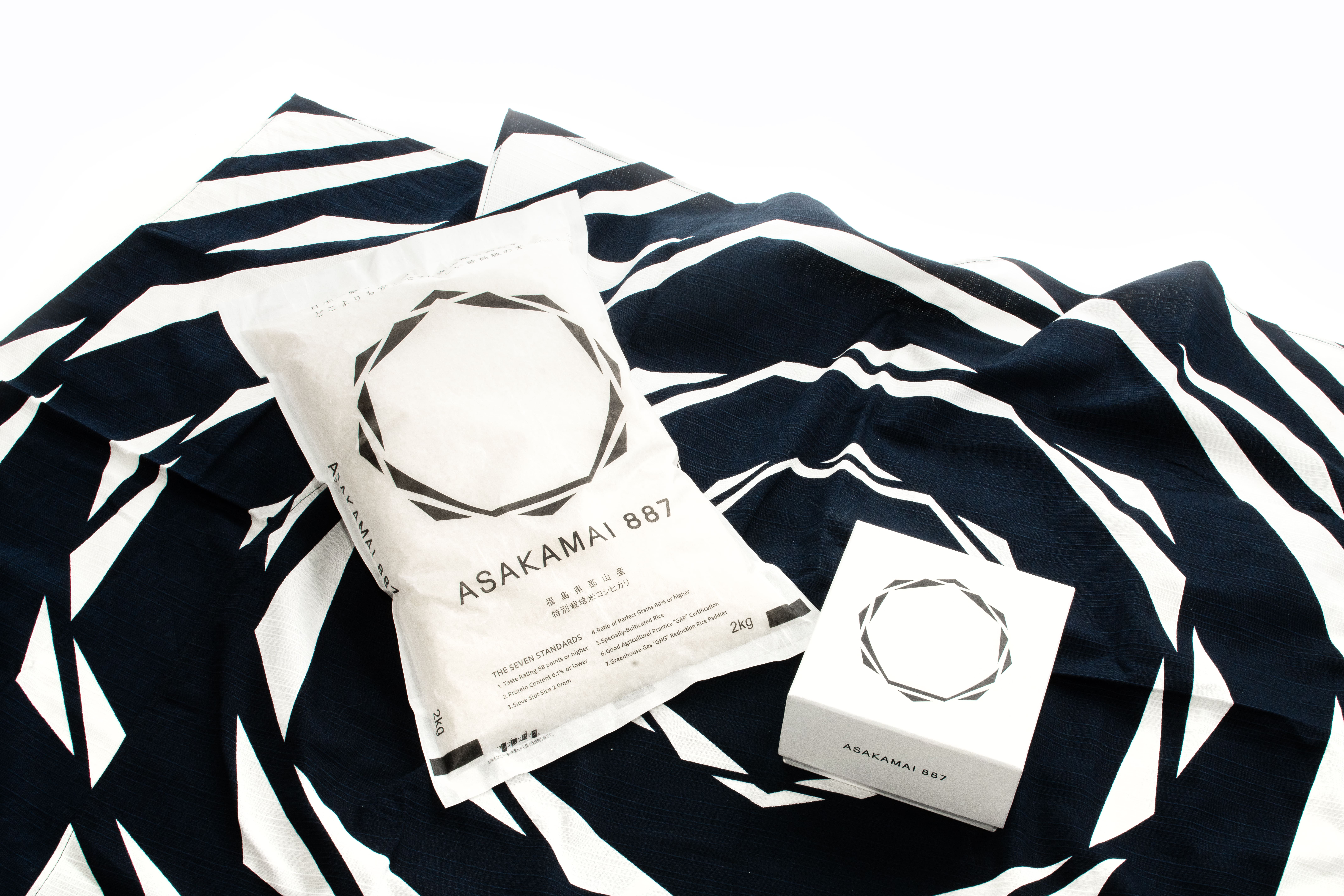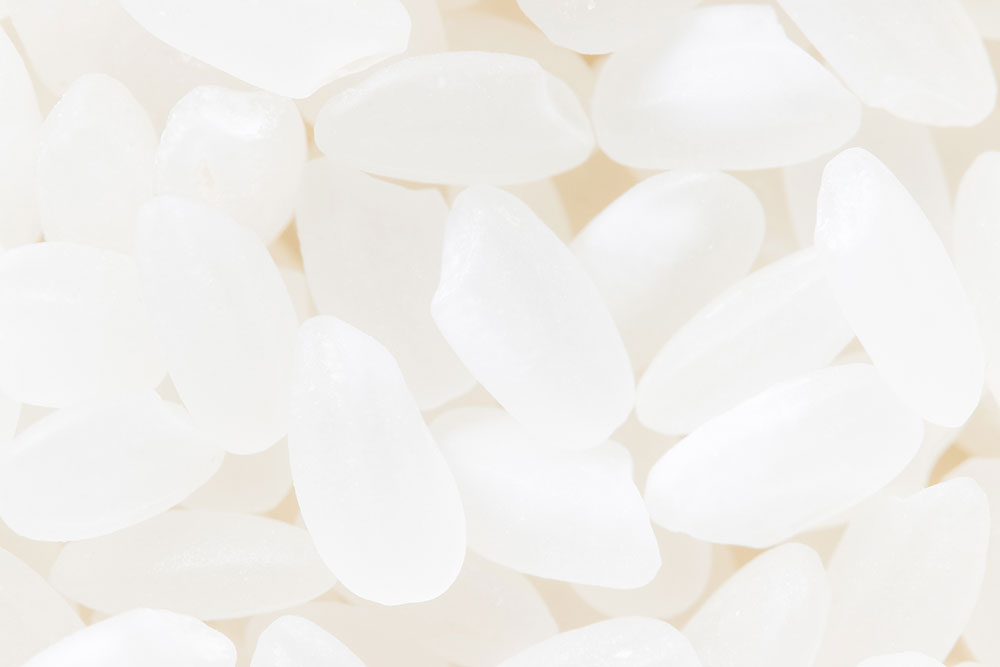

The Love We Put Into Our Riceこの米に込めた想い
どこよりも安全で美味しい最高級の米と、
その生産者の誇りを届ける
明治時代、不毛の大地だった郡山の安積原野を切り拓き、猪苗代湖の豊富な水源を引き込んだ“安積開拓”により、福島県郡山市は豊かな水田が広がる、県内一米づくりが盛んな街になりました。
内陸型の気候、粘土質の土壌、猪苗代湖がもたらす清らかな水、米作りに最適な条件が整ったこの地の田んぼで育てられた郡山産のブランド米「あさか舞」は、おいしいお米として多くの評価を得ています。
しかし、東日本大震災以降、未だ払拭しきれない風評被害によって、郡山産米の価格は、全国平均から大きく下がり、業務用米として安価に扱われているという課題が立ちはだかっています。
このような状況の中、この街で栽培される米の正しい価値を取り戻し、先人たちが築いた「米どころ郡山」の地位と誇りを取り戻すべく、独自に設けた7つの高い生産基準を全て満たす米、“ASAKAMAI 887”の栽培に取り組むプロジェクトが立ち上がりました。
現在、国内では、毎年のように米の新品種が開発され、「ブランド米」が溢れ競争が激しい市場に対して、このプロジェクトでは、郡山市内の米作りの匠たちの技術と想いを結集し、日本の水稲作付け面積3分の1以上を占める“米の王様「コシヒカリ」”を極限まで磨き上げた究極の米「ASAKAMAI 887」として、挑みます。
Bringing you delicious rice of the highest quality, safer than anywhere else, along with the pride of those who make it
During the Meiji period (1868-1912), the barren land of the Asaka plain in Koriyama was cleared. Through the “Asaka Reclamation,” which drew the abundant water source of Lake Inawashiro, abundant rice paddies spread throughout Koriyama, Fukushima, and it became the foremost city in the prefecture for rice production.
ASAKAMAI, the Koriyama rice brand nurtured in paddies with perfect conditions for rice-growing - an inland climate, clay-like soil, and the pure water of Lake Inawashiro - is widely acknowledged as a great-tasting rice.
However, due to harmful rumors that lingered after the 2011 Tohoku earthquake and tsunami, the price of Koriyama rice fell far below the national average. It is treated as low-price, industrial-purpose rice, which poses great challenges.
Against this backdrop, we set out to reclaim the proper value for rice grown in this city, and restore the status and pride of “Koriyama, the land of rice” built by our ancestors. We therefore took up the challenge to grow “ASAKAMAI 887,” a rice that meets all seven of the high production standards that we set for ourselves.
Nowadays in Japan, new varieties of rice are developed almost every year, and the market has fierce competition among the myriad “brand rices.” To this market, we bring our ASAKAMAI 887 project, combining the skills and heart of rice-growing masters in Koriyama city to make the ultimate version of Koshihikari, the “king of rice” that is grown on over a third of Japan’s rice acreage.
ASAKAMAI 887 - 名前の由来
米という漢字は「八」「十」「八」という3つの文字で成り立っています。古くからの由来として、米作りには88の手間がかかると言われてきました。
ASAKAMAI 887は、この88の手間とさらに厳格な7つの生産基準をクリアしたお米のみが冠することができる最高級米です。故に「88」と「7」を組み合わせ、名称といたしました。
ASAKAMAI 887 - The Origin of the Name
The Chinese character for “rice” is composed of three other characters: those for “eight,” “ten,” and “eight.” That is how the number “88” is said in Japanese, and as a character from old, it is said to refer to the fact that making rice requires 88 labors.
As rice of the highest quality, the only rice that can earn the name ASAKAMAI 887 must clear these 88 labors as well as a further seven strict production standards. By combining “88” and “7,” we created the rice’s brand name.
ロゴマーク

ASAKAMAI 887を象徴するシンボルは、名称の由来と同じコンセプトのもとに、88の手間と7つの厳格な生産基準を象徴すべく、8角形と8角形、7角形の組み合わせから産み出されました。
一見複雑な構成に見えるオブジェクトは、一定のルールでレイアウトされ、多様で多層なつくり手、贈り手の想いが共通の課題と生産基準に一丸となってチャレンジする様を表しています。
Logo Mark
The logo for ASAKAMAI 887, based on the same concept as the name’s origin, symbolizes these 88 labors and seven strict production standards. It was made by joining two octagons (eight sides each) with one heptagon (seven sides).
This object, which appears complex at first glance, was laid out using prescribed rules. It expresses the desire of a diverse and multilayered group of producers and distributors to take on shared issues and production standards together as one.

The Seven Standards七つの基準
日本一厳しい基準
郡山の米は、美味しい米との評価を頂いているのに、なぜ価格が低いのか?
震災以降、平均値との価格差が開き、未だ改善されない。風評はこれからも続くのだろうか?
このような状況下で「安全で美味しい米」を作っている生産者の生活とプライドは守られるのか?
ASAKAMAI 887に設定された厳格な7つの生産基準は、これらの課題解決と、どこよりも安全で美味しい最高級の米とその生産者の誇りを届けるために、全量全袋検査、風評払拭、特別栽培米、環境配慮など客観的指標を駆使して設定した、揺るぎない証です。
Japan’s Toughest Standards
Why is it that even though Koriyama rice is recognized as great-tasting rice, its price is so low?
After the 2011 disaster, its price fell below the average, and has never recovered. Will the bad rumors continue?
Against this backdrop, can we protect the livelihoods and pride of those who make “safe, delicious rice”?
In order to resolve these issues and provide delicious rice of the highest quality that is safer than anywhere else, as well as the pride of those who make it, seven strict production standards were placed on ASAKAMAI 887. These standards are solid evidence of the rice’s quality, established by taking full advantage of objective indicators such as blanket radiation checks, rumor dispelling, specially-cultivated rice, and concern for the environment.
食味値 - Taste Rating
-
ASAKAMAI 887
 88点以上
88点以上 -
日本米の平均
 60-65点
60-65点
米のおいしさを示す指数で最高は100点。「米・食味分析鑑定コンクール国際大会」の一次審査は85点以上が条件。それを上回る高レベルの数値、88点以上を基準にしています。
The highest index for showing the taste of rice is 100. A requirement for taking part in the International Contest on Rice Taste Evaluation is receiving a score of 85 or higher on the first test. ASAKAMAI 887 had a level even beyond that, making 88 or higher the standard.
タンパク質含有量 - Protein Content
-
日本米の
玄米平均
7.4% -
6.1%
以下
米はタンパク質が少ないほど水分を十分に吸収して、ふっくらと粘りがある炊きあがりになります。日本米の玄米平均タンパク質含有量7.4%を大きく下回る高い基準を設けています。
The less protein there is in rice, the more moisture it absorbs, which makes it fluffy and sticky when cooked. A high standard was set that is far below the average protein content for unpolished Japanese rice, which is 7.4 percent.
ふるい目 - Sieve Slots
-
2.0mm
1.8〜1.9mm幅のふるい目が一般的ですが、2.0mmのふるい目を使用し大粒のお米のみを選別。粒ぞろいが非常に良いことから、口に入れたときの舌や歯ざわりが良く、食味が向上します。
Rice that makes it through sieve slots 1.8-1.9mm wide are the norm, but we select only large-grain rice that gets through 2.0mm sieve openings. As the grains are high quality and uniform in size, the rice has excellent texture and improved taste.
整粒歩合 - Ratio of Perfect Grains
-
80%
以上
米の状態を見極める基準のひとつで、一定量の玄米のなかで、きちんと整った形をしている米粒の割合を%で示した値です。一等米で70%以上で、それを上回る基準を設けています。
One standard for ensuring rice quality is the proportion of perfectly formed rice grains, expressed as a percentage value. The value is 70 percent or more for first-class rice, and our own standard is set even higher.
特別栽培米 - Specially-cultivated Rice
国が定めた「特別栽培農産物に係る表示ガイドライン」に基づき、慣行米より「節減対象農薬の使用回数が50%以下、化学肥料の窒素成分量が50%以下」で栽培された米。福島県特別栽培農産物認証制度による認証を受けることが条件となります。
Based on the “Display Guidelines Related to Specially-Cultivated Agricultural Products” set by the government, our rice is grown with “a 50 percent or less instances of agrochemical use, and 50 percent or less of the nitrogen component amount in chemical fertilizers” compared to conventional rice. The rice must be certified under the Fukushima Prefecture Specially-Cultivated Agricultural Product Certification System.
GAP認証 - GAP Certification
ASAKAMAI 887の生産者は、農業の生産工程の管理に取り組むGAP認証を受けています。生産現場において食品の安全確保、環境の保全、労働の安全などの観点から安全に農業生産を実施するための管理ポイントを整理しそれぞれを記録・検証して農業生産を行っている生産者によって栽培された米です。
Producers of ASAKAMAI 887 are GAP certified to manage their agricultural production processes. The rice is grown by producers who organize, record, and verify control points for safe agricultural production from the perspectives of food safety, environmental conservation, and labor safety at the production site.
カーボンニュートラル水田 - Carbon neutral paddy fields
温暖化に影響するメタンガス。水田からのメタンガス発生を抑制するための取り組みとして、中干し期間を通常よりも延長することで、土壌中により多くの酸素が供給され、メタン生成菌の活動を抑制し、温室効果ガスの排出量を低減させる配慮がなされた水田で栽培されています。
Methane gas affects global warming. In an effort to reduce methane gasemissions from rice paddies, the paddies are cultivated in consideration of suppressing the activity of methanogenic bacteria and reducing greenhouse gas emissions by supplying more oxygen to the soil and by extending the drying period longer than usual.
